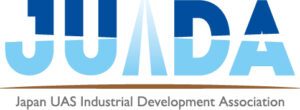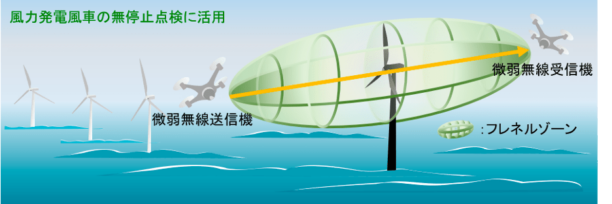 This article was published in collaboration with JuidaJapan UAS Industry Promotion Association
This article was published in collaboration with JuidaJapan UAS Industry Promotion Association
Japanese company showcases first non-stop wind turbine inspection technology using drones
DRONELIFE Staff Writer Ian J. McNabb
 At the recent Tsukaba Forum in Japan, Tokyo-based Nippon Telegraph and Telephone Corporation (NTT) recently unveiled a new technology for non-stop inspection of wind turbines, showcasing its innovative approach. A demonstration experiment was announced. Conventional inspection methods require the turbine to be completely stopped before inspection, which is difficult and has a significant impact on power generation efficiency. NTT’s new process uses two of his autonomous drones with relatively small commercial radio transmitters to transmit weak radio signals between them (no federal license required). This creates a “Fresnel Zone” between his two UAVs that can form on either side of the turbine, sensing damage or other problems across the unit while continuing to operate.
At the recent Tsukaba Forum in Japan, Tokyo-based Nippon Telegraph and Telephone Corporation (NTT) recently unveiled a new technology for non-stop inspection of wind turbines, showcasing its innovative approach. A demonstration experiment was announced. Conventional inspection methods require the turbine to be completely stopped before inspection, which is difficult and has a significant impact on power generation efficiency. NTT’s new process uses two of his autonomous drones with relatively small commercial radio transmitters to transmit weak radio signals between them (no federal license required). This creates a “Fresnel Zone” between his two UAVs that can form on either side of the turbine, sensing damage or other problems across the unit while continuing to operate.
By 2040, more than 3,600 new wind turbines will be built in Japan, which has invested heavily in wind power, building new large-scale power plants off its long coastline, according to a press release from NTT. I plan to Finding improved ways to serve units in remote areas is important for Japan. Autonomous drones will make inspections of offshore turbines much easier as they ease the transition to greener forms of energy. Using a radio field, the drone accurately measured the extent of damage to the movable turbine arm, albeit in a controlled laboratory environment, without the need for constant analysis.
Working on wind turbines can be dangerous, with frequent storms and dizzying heights, making regular maintenance a major obstacle. NTT hopes that integrating more remote and autonomous systems with wind farms will lead to a greener and more efficient future. While the technology is promising, so far it is mostly a proof of concept and NTT has not announced a release schedule, but innovative applications for drones are emerging around the world, especially when it comes to renewable energy deployments. It will continue to emerge throughout the economy. energy sources around the world. According to NTT, next steps will include extensive outdoor testing on multiple functional units to further develop the process.
read more:
Miriam McNabb, editor-in-chief of DRONELIFE and CEO of professional drone services marketplace JobForDrones, is a keen observer of the emerging drone industry and drone regulatory environment. Miriam is an international speaker and industry recognized figure, with over 3,000 articles focused on the commercial drone space. Miriam has a degree from the University of Chicago and he has over 20 years of experience in high tech sales and marketing new technologies.
For drone industry consulting or writing, email Miriam.
twitter:@spaldingbarker
Subscribe to Drone Life here.
